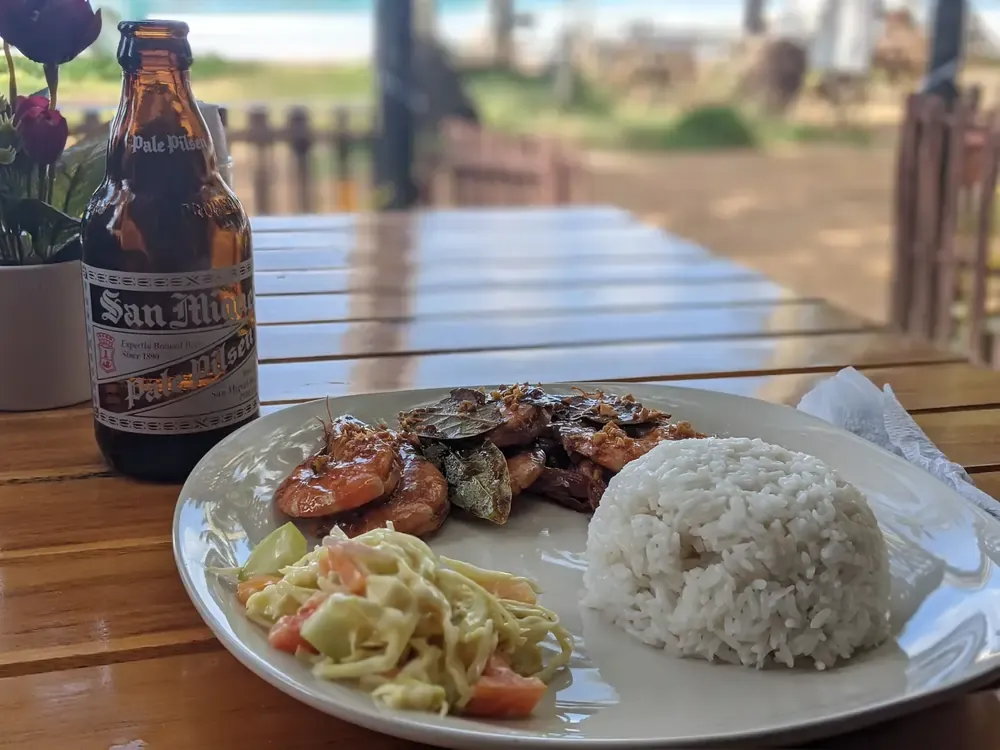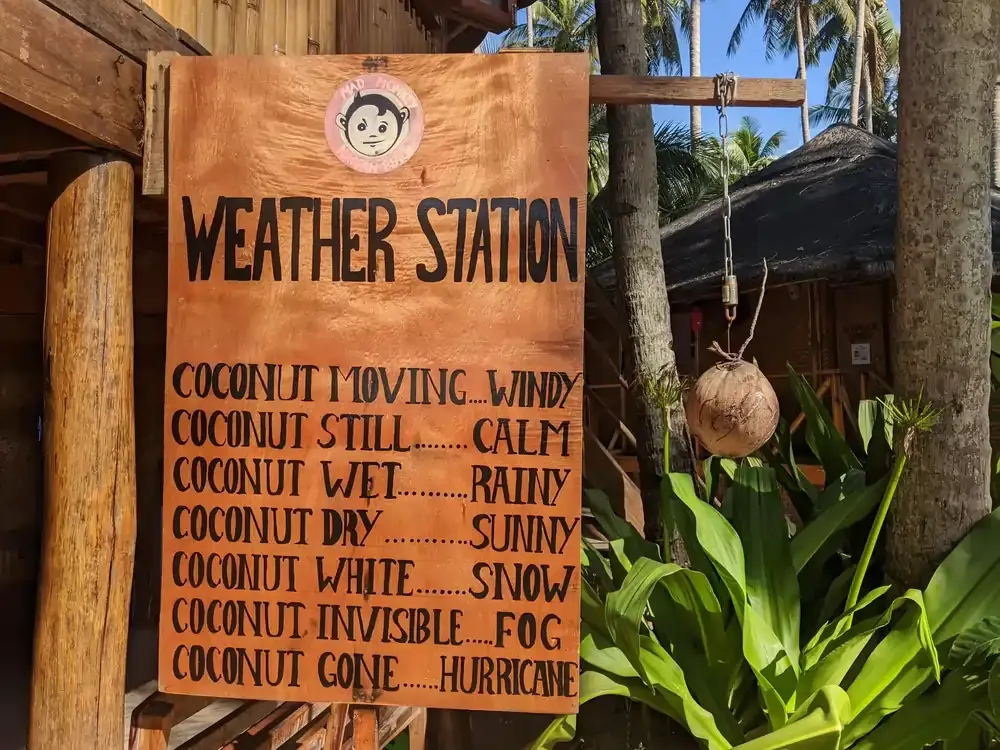travel content
10 INSIDER Philippines Travel Tips (Written By a Local)
A guest post from Project Untethered
A trip to the Philippines is not just about where you go, but also the fun you have along the way.
To maximize your fun, there are some important things you need to know — things that could throw a wrench in your travel plans if you aren’t careful.
About the Writer

My name’s Lianne, I’ve lived my entire life in the Philippines. I’m currently island-hopping around the country as a digital nomad while working as a content creator for the Project Untethered travel blog.
So if you’re looking for insider Philippines travel tips, I’m your gal.
Let’s dive in.
1. Check the weather before travelling
The Philippines is a hotspot for typhoons. In fact, 8 to 9 tropical cyclones hit the country each year, mostly from June to October. However, typhoons also occasionally hit during the summertime in the Philippines, which is from March to May.
If you travel during these months, it’s a good idea to check the weather shortly before leaving on your trip, as well as every day during your trip.
This sounds obvious, but the last thing you want is to get stranded on an island during a storm. You also don’t want your things getting flooded, especially in areas close to the sea or rivers.
If you’re already in the Philippines and you find out a typhoon is coming, don’t panic.
Your goals should be to stock up on food and supplies, and find a safe place to stay (i.e. move out of that creaky beach bungalow into a well-built hotel).
Malls usually stay open, but some smaller shops like pharmacies and banks might close down.
Flights and ferry schedules get cancelled too, so there’s the added stress of having to rebook flights or rearrange your itinerary.
That said, the best time to visit the Philippines is usually between December and May when the weather is more predictable and generally pleasant.
Yes, you’ll pay slightly higher prices and have to share the beach with more people. But you won’t have to worry about the weather.
While it’s all part of the adventure, a bit of planning makes for a smoother and more enjoyable trip.
2. Bring an eSim or portable WiFi
The WiFi in the Philippines is hit or miss. It’s available in most hotels and cafes in urban areas, but not so much in rural islands (AKA the most beautiful places).
The easiest way to stay connected is to load up a SIM card or eSIM onto your phone.
It’s convenient and gives you consistent internet access for work, navigation, or keeping in touch with your loved ones.
There are several prepaid SIMs you can choose from, but Globe and Smart are usually the top picks for tourists.
Some airports sell SIM cards, but others don’t. If not, you’ll have to do some hunting. One option is to go directly to a Globe or Smart store, often found in malls.
You can also find them in some 7/11 convenience stores, but these can be hit or miss, so it may take some patience.
Alternatively, Nomad eSIMs are a convenient option because they use the Globe network, which has strong coverage throughout the Phiilippines.
They’re also easy to install by yourself, and you can do it before leaving home. That saves the hassle of hunting down a physical SIM card when you arrive.
For a full review of how the service works, this Nomad eSIM review shares honest insights from a traveler who tests eSIMs all over Southeast Asia.
Malls and public places often offer free public WiFi, but I wouldn’t depend on it too much. Speeds can be quite limited and the signal isn’t always great.
You could probably get by using public wifi for emergencies — like sending a message or a slow internet search. But don’t count on it for scrolling Instagram or planning out the next steps of your trip.
3. Booking in advance to avoid peak seasons
If you want to save a bit of money when you travel, book your tickets in advance. Flights, hotels, and tours get more expensive when you book closer to the travel date.
Peak domestic travel season is also something to consider when planning your trip.
It’s usually from December to May during holidays like Christmas, New Year, and Holy Week.
During this time, top destinations get packed with both foreign and locals traveling domestically.
Aside from crowds, you can expect higher prices during this time. But as mentioned, you also get better weather.
4. Try local cuisine
The best way to learn about any culture is through food. And the Philippines has no shortage of local delicacies.
Aside from the usual adobo or lechon, each region has its own unique dish that you won’t find anywhere else.
I recommend trying laing when you’re visiting Bicol. It’s a vegetable dish made with taro leaves soaked in coconut milk and spicy chilies.
If you’re feeling adventurous, you can try street food like isaw (chicken intestines), betamax (pork blood sausage), or my personal favorite, balut (fertilized duck egg embryo).
It’s all about keeping an open mind and a curious palette.
Look for street stalls that are packed with people since this is a good indicator that the place serves the real deal.
For a truly immersive experience, ask the locals. They always know the best spots for authentic and delicious Filipino food.

5. Expect delays wherever you go
In the Philippines, time is flexible.
This means schedules are more like guidelines rather than a strict rule. We call it 'Filipino Time.'
It’s a habit that got passed down from the Spanish who occupied the country hundreds of years ago.
Whether it's transportation, service at restaurants, or even organized tours, delays are common.
It’s the same whether you're in a big city like Manila, or a beach town in Palawan.
You can also expect some waiting time at airports.
It sounds inconvenient, but this laid-back lifestyle is a big part of the local culture, so it's best to adopt a flexible itinerary.
Always allow extra time for travel and activities, and use these unexpected pauses to soak in the beauty of the surroundings.
6. Public transportation isn’t the best
Traveling around the Philippines by public transport can be quite an experience.
Buses, jeepneys, and tricycles are the main modes of public transportation.
When taking a bus or a jeepney, look at the window sign next to the driver to know the destination. Prices vary depending on where you’re going so it’s best to ask around for the fare.
When paying for the bus, a bus conductor will approach you. For the jeepney, you hand it to the person next to you so they can give it to the driver.
Tricycles (three-wheeled moto-taxi similar to tuktuks or rickshaws) are a good option for places where other public transport isn’t as accessible.
If you’re in Metro Manila, you can also use the MRT and the LRT public transportation system. You can either use a beep card, which is a reloadable card, or a single journey ticket. Just go to the cashier at any station to pick up whichever you choose.
That said, expect crowded spaces and unpredictable schedules.
A more convenient option is taking a taxi or booking a Grab rideshare.
If you have the budget, you can also rent a car or motorcycle instead. There are plenty of vehicle rental services in popular tourist destinations.
Most major cities have good asphalt roads for driving. In rural areas, roads can be bumpy and rocky with animals known to dart out unexpectedly into the streets — so be extra careful if riding a motorcycle.
In most cases, you’ll visit more than one island, which means you’re also looking at a domestic flight or ferry. It’s a good idea to prepare for long lines, especially during peak season.
My advice is to arrive at the airport or ferry terminal at least 3-4 hours before your schedule so you’ll have enough time to check in your baggage, pay the fees, and secure your tickets or boarding pass.
7. Protect your stuff
Filipinos are friendly and welcoming. But like any popular destination, there's a risk of petty theft especially in busy tourist spots.
Always keep an eye out for your belongings. Use anti-theft backpacks or money belts for extra security.
In crowded areas, carry your bag in front of you and watch out for distractions that might be tricks for pickpocketing. Some common scams include street kids asking for money or strangers randomly chatting you up in perfect English.
Try not to show off expensive jewelry or gadgets. If you're staying in a hostel, use safes or lockers for your valuables.
Another tip is to have copies of important papers like your passport and ID.
If your stuff does get stolen, be aware that local police procedures can be lengthy and stressful. Recovering lost items isn't always guaranteed.
It's best to take steps to avoid these situations so you can enjoy your trip in the Philippines without worrying.
8. Everyone speaks English
One of the great conveniences of traveling in the Philippines is that everyone knows English.
It's one of the official languages, and most Filipinos speak it fluently.
This makes communication a breeze, whether you're asking for directions, ordering food, or chatting with locals.

It also means that signs, menus, and travel guides are often available in English, making it easier to get around.
That said, it’s still useful to know some basic Filipino words.
Simple phrases like “Salamat” (Thank you) and “Magandang umaga” (Good morning) can go a long way in showing respect for the locals.
9. Go island hopping
Island hopping is a must-do in the Philippines, with its 7,000+ islands.
Each island has its distinct charm, and while it's tempting to see as much as possible, it's important not to overfill your itinerary.
Taking the time to truly explore and appreciate each island enhances the experience.
I recommend islands like Boracay, Siargao, Palawan, and Cebu. The beaches there are unbelievable.
But my personal favorite is Siquijor Island. It’s not quite as popular as the others I mentioned, but that means fewer crowds and a more relaxing environment.
When packing for these adventures, practicality is key.
Remember to bring aqua shoes to protect your feet against sharp rocks and coral reefs. A waterproof case for your gadgets also helps.
Most importantly, respect the local environment. Avoid littering, don’t mess with the wildlife, and follow local conservation guidelines.
The natural beauty of the Philippines is breathtaking and well worth the effort to preserve.

10. Always carry cash
While credit cards are accepted in major cities, cash is still king in many parts of the Philippines.
Keep this in mind if you plan on exploring off-the-beaten-path destinations like Sagada and Batanes Island.
One thing to watch out for is hidden fees. In some remote areas, additional charges for card transactions are common practice.
Plus, ATMs aren’t always available. When you do find them, they may have lower withdrawal limits than what you're used to.
It's good practice to withdraw enough cash in larger towns or cities before heading to more secluded locations.
Smaller denominations are handy for everyday purchases like food, trinkets, or local transport, while larger notes are useful for bigger expenses like accommodations.
Money changers are widely available, but their exchange rates can vary.
Money changers in airports usually have lower exchange rates compared to those in malls.
Keep these tips in mind to travel the Philippines like a local!